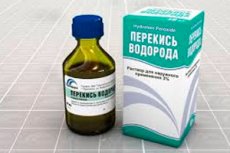Hydrogen peroxide vapor poisoning
Last reviewed: 06.10.2024

All iLive content is medically reviewed or fact checked to ensure as much factual accuracy as possible.
We have strict sourcing guidelines and only link to reputable media sites, academic research institutions and, whenever possible, medically peer reviewed studies. Note that the numbers in parentheses ([1], [2], etc.) are clickable links to these studies.
If you feel that any of our content is inaccurate, out-of-date, or otherwise questionable, please select it and press Ctrl + Enter.

Hydrogen peroxide (peroxide) in a small concentration has powerful antiseptic properties. The substance is also used for industrial purposes, as the concentrated solution has pronounced oxidizing and bleaching properties.
Causes of the hydrogen peroxide poisoning
Intoxication of the body occurs when inhaling peroxide vapors, as well as when it is ingested.
- Inhalation of concentrated liquid vapors causes acute irritation of the mucous membranes of the respiratory tract. This leads to the development of edema, inflammation and impaired respiratory function.
- More dangerous is ingestion of the solution. This leads to burns of the oral mucosa, esophagus, stomach with ulcers and erosions. At decomposition of peroxide oxygen bubbles are formed, which penetrate through damaged tissues into blood vessels, causing acute circulatory failure - embolism.
- If the concentrated liquid gets on the skin, it leads to irritation, redness and development of chemical burns of varying severity.
Symptoms of the hydrogen peroxide poisoning
Signs of peroxide exposure to the body:
- A scratchy throat.
- Dry cough.
- Shortness of breath.
- A metallic taste in my mouth.
- Swelling of the respiratory mucosa.
- Airway obstruction, mechanical asphyxia, respiratory arrest.
If the substance was ingested, it causes sharp pain in the oropharynx, pain along the course of the esophagus and in the stomach area, nausea and vomiting, and choking. If a solution with a concentration of more than 30% has been ingested, the pain is so intense that pain shock, loss of consciousness and coma develop.
One of the dangers of inhalation exposure to peroxide is complications: pneumonias, GI bleeding, esophageal strictures, gas embolisms, and more.
Treatment of the hydrogen peroxide poisoning
The first thing to do in case of pathological effect of peroxide on the body is to call an ambulance. Before the arrival of medics, the victim is taken out into fresh air, washed face with clean water.
If the liquid has been taken internally, the patient is given activated charcoal and plenty of fluids to reduce the concentration of the toxin in the body. If external exposure - the skin is washed with cold water and treated with citric acid (inhibits the effect of the toxin).
Here's what treatment at a medical facility might look like:
- Medical Evaluation and Stabilization: The victim will be medically evaluated to determine the severity of the poisoning and to stabilize their condition. This includes evaluation of respiratory, cardiovascular and other organ function.
- Respiratory modification and oxygen therapy: In hydrogen peroxide poisoning, respiratory support and oxygen therapy may be required to ensure adequate oxygen supply to the body.
- Detoxification: Detoxification methods may be used to remove hydrogen peroxide from the body. This may include gastric lavage, administration of activated charcoal, or other methods to bind and remove the toxin.
- Symptomatic treatment: Treatment is aimed at reducing symptoms of poisoning such as nausea, vomiting, headache and others. This may include the use of antiemetics, anticonvulsants, etc.
- Medical supervisionand rehabilitation: The injured person will be under the supervision of medical personnel to monitor his/her condition and provide rehabilitation measures if necessary.
- Treatment of complications: Hydrogen peroxide poisoning can lead to various complications such as burns to mucous membranes, organ damage, and others. Treatment is aimed at preventing and treating these complications.

